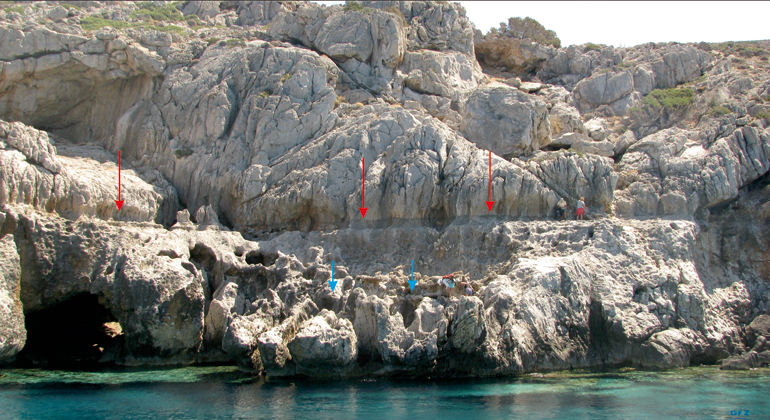Eastern Mediterranean Earthquake Risk Revisited
The number of earthquake and tsunami sources in the Eastern Mediterranean is considerably higher than assumed previously.
Moreover, on a geological time scale these sources generate large earthquakes in bursts. These findings are presented by a group of geoscientists from the GFZ German Research Centre for Geosciences, the Canterbury University, and GNS Science in New Zealand in the recent edition of the magazine “Geophysical Research Letters”. Following the study’s results, the seismic risk is higher than estimated previously.
The seafloor of the Mediterranean is a puzzle of minor blocks and fragments caused by the collision of the African and the Eurasian Plates. This results in a pronounced earthquake risk in the Eastern Mediterranean. But why has this seismically most active region in Europe produced only two known large magnitude earthquakes with magnitudes larger than M 8 since the Minoan period, i.e more than 4000 years?
South of the island of Crete, the African part of the seafloor subducts under the Aegean microplate in Eastern Mediterranean. By exploring the earthquake history of this subduction system, the geoscientists aim to obtain a better understanding of the key processes that control the generation of earthquakes and their recurrence intervals. “We study the Hellenic subduction margin going back to about 50 thousand years which is about ten times the time-window of paleoearthquake observations in Eastern Mediterranean that we had before,” says Vasiliki Mouslopoulou (GFZ), lead author of the study. “For the first time ever, we were able to chart the spatial and temporal pattern with which mega-earthquakes rupture the Hellenic margin.”
The geoscientists integrated field studies with radiometric dating and numerical models for a section of the Hellenic margin that straddles the island of Crete. Specifically, the experts identified and recorded relict shorelines all along Crete, which are today elevated up to 23 meters above sea-level. Each of these paleo-shorelines is thought to represent the past sea-level at the time of its formation while its altitude (relative to sea-level) reflects the total vertical movement that this paleoshoreline experienced due to earthquake motion. By radiocarbon-dating the fossilised marine fauna that mantles each paleoshoreline, the scientists found that during the last 50 thousand years both, western and eastern Crete, have been uplifted uniformly by about 100 meters due to at least 40 large magnitude earthquakes with magnitudes larger than M 8. The origin of these quakes was offshore, on three seismic faults that extend along the western and eastern section of the Hellenic margin. It appears that the eastern segment of the margin does not slide mainly aseismically, as was so far considered, but instead is capable of causing large quakes. This implies that the seismic hazard in Eastern Mediterranean is significantly higher than previously thought.
Yet another surprise was the strong clustering of quakes in the analyzed period: “We also found that, in contrast to most subduction margins globally, great earthquakes in the Hellenic margin are strongly clustered in time” GFZ researcher Mouslopoulou explains. “The data show that most of these paleo-earthquakes occurred over a time-period of about 10 thousand years while there were long periods (up to 20 thousand years) of relative seismic quiescence.” For example, the fault beneath western Crete appears to have ruptured every 4500 years when its activity is averaged over the last 50 thousand years, as frequently as every 1500 years between 5 and 20 thousand years ago, and not at all between 0 to 3000 years BC. More or less, the same applies for the other two seismic sources.
This high variability in the occurrence of large-earthquakes in Eastern Mediterranean makes the calculation of their repeat-time a great challenge. Thus, while currently the Hellenic margin experiences a seismically quiet period, future great earthquakes can be expected beneath both eastern and western Crete, although fluctuations in recurrence intervals mean that constraining the timing of these events represents a challenge. However, precautions such as tsunami early warning systems and earthquake resistant construction will have to be based on an increased potential risk.
Source
Helmholtz Centre Potsdam – GFZ German Research Centre for Geosciences 2015








